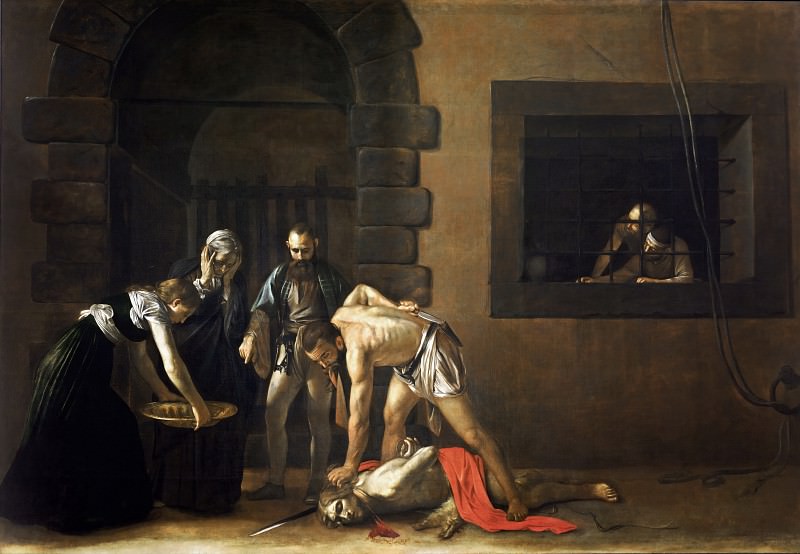Beheading of Saint John the Baptist Michelangelo Merisi da Caravaggio (1571-1610)
Michelangelo Merisi da Caravaggio – Beheading of Saint John the Baptist
Edit attribution
Download full size: 6250×4326 px (6,2 Mb)
Painter: Michelangelo Merisi da Caravaggio
The painting was created by the painter in 1608 on the well-known subject of the execution of John the Baptist. This is the last phase of Caravaggio’s (real name: Michelangelo Merisi da Caravaggio) oeuvre, when his paintings were fully immersed in a world of somber, dark colors and equally dark subjects. This is not the only work by the artist illustrating the last moments of the earthly life of the saint who predicted the appearance of Jesus Christ to the world. The gloomy walls of the prison in the spirit of austere Renaissance asceticism, the almost complete absence of props, so that the imposing spaces of the painting remain empty, the terrible event, which in a moment will happen, it seems, in the presence of the viewer, puts one in awe. The almost palpable sense of horror that is natural to the audience is reflected in different ways in the facial expressions and poses of the participants in the event.
Description of a painting by Merisi da Caravaggio The Beheading of John the Baptist
The painting was created by the painter in 1608 on the well-known subject of the execution of John the Baptist. This is the last phase of Caravaggio’s (real name: Michelangelo Merisi da Caravaggio) oeuvre, when his paintings were fully immersed in a world of somber, dark colors and equally dark subjects.
This is not the only work by the artist illustrating the last moments of the earthly life of the saint who predicted the appearance of Jesus Christ to the world.
The gloomy walls of the prison in the spirit of austere Renaissance asceticism, the almost complete absence of props, so that the imposing spaces of the painting remain empty, the terrible event, which in a moment will happen, it seems, in the presence of the viewer, puts one in awe.
The almost palpable sense of horror that is natural to the audience is reflected in different ways in the facial expressions and poses of the participants in the event. The actions of the jailer and the executioner are businesslike and commonplace. One directs the execution, the other does his job: pressing the poor man’s head to the floor, he is ready to make the decisive swing of the knife clutched in his hand behind his back.
Salome holds a golden platter in readiness - in a moment the head of the murdered sufferer will be placed there. The only one who is moved by the mournful action is the unmarried woman, who grips her bowed head with her hands in sorrow. The inmates observing the action from behind the bars are more curious than compassionate, which is quite natural at such a moment.
The size of the canvas surpasses that of the artist’s other altarpieces. The enormous size of the canvas allowed Caravaggio to depict the characters in life-size, but even such impressive figures could not fill the entire space of the artist’s large-scale work.
In the middle of the 20th century a full-scale restoration was made of the work, as the canvas was badly damaged and in a poor condition. The restorers discovered a surprising find: a brief inscription, cleverly hidden from view under a small pool of blood of the executed.
At first, it was thought that the author had signed his creation. Later, however, art historians, in the course of long discussions, decided that the few Latin letters were a kind of autograph of the painter, by which he confessed in passing to the crime committed by Caravaggio a few years earlier.
The original was deposited by the clergy at St. John’s Cathedral, in Valletta, the capital of Malta.
Кому понравилось
Пожалуйста, подождите
На эту операцию может потребоваться несколько секунд.
Информация появится в новом окне,
если открытие новых окон не запрещено в настройках вашего браузера.
You need to login
Для работы с коллекциями – пожалуйста, войдите в аккаунт (open in new window).



![Michelangelo Merisi da Caravaggio - Young Woman [School of]](http://cdn.gallerix.asia/j/C/438722921/3726.webp)


![Michelangelo Merisi da Caravaggio - Portrait of a Young Man [School]](http://cdn.gallerix.asia/j/C/438722921/6132.webp)













You cannot comment Why?